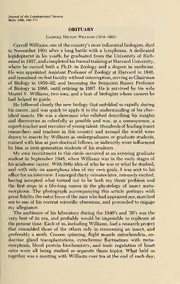
Obituary. Carroll Milton Williams (1916-1991) PDF
Preview Obituary. Carroll Milton Williams (1916-1991)
JournaloftheLepidopterists'Society 46(2), 1992, 169-171 OBITUARY Carroll Milton Williams (1916-1991) Carroll Williams, one of the country's most influentialbiologists, died in November 1991 after a long battle with a lymphoma. A dedicated lepidopterist in his youth, he graduated from the University of Rich- mondin 1937,andcompletedhisformaltrainingatHarvardUniversity, where he earned both a Ph.D. in Zoology and a degree in medicine. He was appointed Assistant Professor of Zoology at Harvard in 1946, andremainedon thatfaculty without interruption,servingasChairman of Biology in 1959-62, and becoming the Benjamin Bussey Professor of Biology in 1966, until retiring in 1987. He is survived by his wife Muriel V. Williams, two sons, and a host of biologists whose careers he had helped to guide. He followed closely the new biology that unfolded so rapidly during his career, and was quick to apply it to the understanding of his cher- ished insects. He was a showman who relished describing his insights and discoveries as colorfully as possible and was, as a consequence, a superbteacherandrecruiterofyoungtalent. Hundredsofleadinginsect researchers and teachers in this country and around the world were drawn to insects by Williams as undergraduates or graduate students, trained with him as post-doctoral fellows, or indirectly were influenced by him as next-generation students of his students. My own recruitment to this circle occurred as an entering graduate student in Septeniber 1948, when Williams was in the early stages of his academic career. With little idea of who he was or what he studied, and with only an amorphous idea of my own goals, 1 was sent to his officeforaninterview. I emergedthirty minuteslater, intenselyexcited, having accepted what turned out to be both my thesis problem and the first steps in a life-long career in the physiology of insect meta- morphosis. The photograph accompanying this article portrays with greatfidelitytheouterforceofthemanwhohadappraisedme,matched me to one of his current scientific obsessions, and proceeded to engage my allegiance. The ambience of his laboratory during the 1940's and '50's was the very best of its era, and probably would be impossible to replicate at the present time. Each of us, including Williams, had a research project that resembled those of the others only in concerning an insect, and preferably a moth. Cocoon spinning, flight muscle mitochondria, en- docrine gland transplantations, cytochrome fluctuations with meta- morphosis, blood protein biochemistry, and ionic regulation of heart rates were all being studied as separate thesis topics. What held us together was a meeting with Williams over tea at the end of each day, 170 Journal of the Lepidopterists' Society when we talked about each other's experiments, subjected his results to the same spirited scrutiny as our own, and served as an enchanted audience for his colorful and strongly opinionated conversations. His most important early work dealt with the hormonal control of Volume 46, Number 2 171 — pupaldiapauseandmetamorphosisintheCecropiasilkworm asubject that he worked by himself with neither technical nor student assistance. Hespent Saturdaysin hissurgery anesthetizing pupae, cutting windows in their cuticle, transplanting tissues, and implanting chemicals, while a Red Sox game, in season, played in the background. His experiments complemented those elsewhere on other orders of insects in establishing how the prothoracic glands, corpora cardiaca, corpora allata, and the brain interact to control metamorphosis and molting. He was an in- novative surgeon, and had astutely chosen the diapausing lepidopteran pupa as a system that would clearly distinguish between the roles of the hormones that interested him. His isolated pupal abdomen prep- aration was used to demonstrate, among other things, that the steroids crystallized by Karlson and Butenandt in 1952 were in fact the molting hormone secreted by the prothoracic glands. And he began the parade toward juvenile hormone identification with his demonstration in 1956 that ether extracts of the imaginal male abdomen of Cecropia were a rich source of corpus allatum activity. In later years, as teams of biochemists followed in the wake of the pioneers of insect endocrinology, Williams became an advocate of the use of metamorphosis hormones and their analogues as pesticides, and of the study of plant-insect interactions mediated by these powerful substances. He played other roles as well, especially through his chair- manshipofBiologyatHarvard (whichbeganaprofoundmetamorphosis duringhistenure),aschairmanoftheSectiononZoologyoftheNational Academy of Science, and as consultant to chemical industries striving to develop new strategy insecticides. Recalling Williams' extraordinarily productive career highlights the profoundinfluencethatthepreoccupationsofyouthcanhaveinshaping a career. The study of Lepidoptera provided not only an early arena for exercising his extraordinary gifts, but the roots that oriented and sustained his exceptional career. William H. Telfer, Department ofBiology, University ofPennsylvania, Philadel- phia, Pennsylvania 19104-6018 Date of Issue (Vol. 46, No. 2): 20 August 1992
